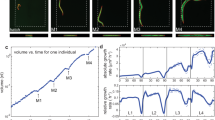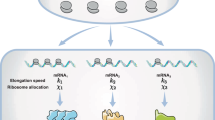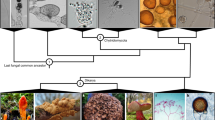Abstract
FOR many years past, biologists have been interested in the rates of growth of parts of organisms in relation to the whole or to other parts. Such ratios were termed by Huxley1 constant differential growth-ratios, and the whole process by Pezard2 heterogony. The process may obviously be either positive, if the relative size of the part increases with time (that is, grows more rapidly than the whole), or negative, if the relative size diminishes (that is, grows more slowly). If it attains an extreme degree, it might be called, in Champy's phrase3, dysharmonic growth. Some authors, for example, Teissier4 (who, with Needham5, introduced the application of these concepts to the chemical constitution of the body) at first adopted this usage; but it has not proved acceptable, since, if we liken the organism to a piece of music, the growth of all parts at the same rate would be unison, and their growth at different rates harmony, not disharmony. Later, after the term heterogony had come into very general use, Huxley and Teissier6 proposed its replacement by allometry on the ground that heterogony had previously for a long time been employed by sex physiologists to denote a special type of reproductive cycle.
This is a preview of subscription content, access via your institution
Access options
Subscribe to this journal
Receive 51 print issues and online access
$199.00 per year
only $3.90 per issue
Buy this article
- Purchase on SpringerLink
- Instant access to full article PDF
Prices may be subject to local taxes which are calculated during checkout
Similar content being viewed by others
References
Huxley, J. S., "Problems of Relative Growth" (London, 1932).
Pezard, A., Bull. Biol. Fr. and Bolg., 52, 1 (1918).
Champy, C., "Sexualité et Hormones" (Paris, 1924).
Teissier, G., Trav. Stat. Biol. Roscoff 9, 27 (1931).
Needham, J., Biol. Rev., 8, 180 (1933).
Huxley, J. S., and Teissier, G., NATURE, 137, 780 (1936).
Roux, W., Correns, C., Fischel, A., and Küster, E., "Terminologie der Entwicklungsmechanik" (Leipzig, 1912).
Hersh, A. H., Amer. Nat., 68, 537 (1934).
Lumer, H., Amer. Nat., 74, 439 (1940).
Lerner, I. M., Gregory, P. W., and Goss, H., Proc. Soc. Exp. Biol. and Med., 35, 283 (1936).
Osborn, H. F., Amer. Nat., 66, 52 (1932).
Thompson, d'Arcy, "Growth and Form" (Cambridge, 1917).
Author information
Authors and Affiliations
Rights and permissions
About this article
Cite this article
NEEDHAM, J., LERNER, I. Terminology of Relative Growth-Rates. Nature 146, 618 (1940). https://doi.org/10.1038/146618a0
Issue date:
DOI: https://doi.org/10.1038/146618a0
This article is cited by
-
Relative Growth of Organs and Tissues in Mammals
Nature (1956)
-
Observations on the mutant ‘pygmy’ in the house mouse
Journal of Genetics (1955)
-
Influence of Sodium Thiocyanate on the Development of the Chick Embryo
Nature (1946)
-
An Application of the Principles of Allometry to the Study of English Senonian Echinocorys
Nature (1943)
-
Terminology of Relative Growth–Rates
Nature (1941)



